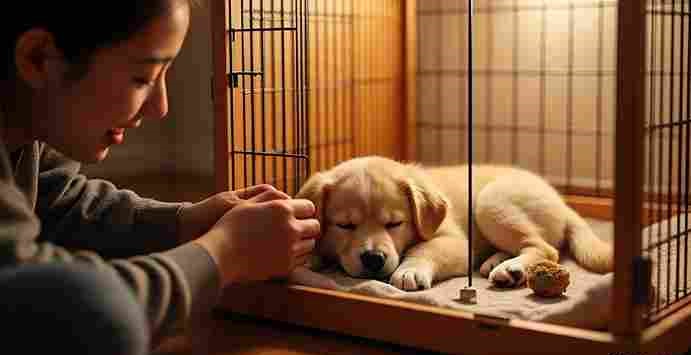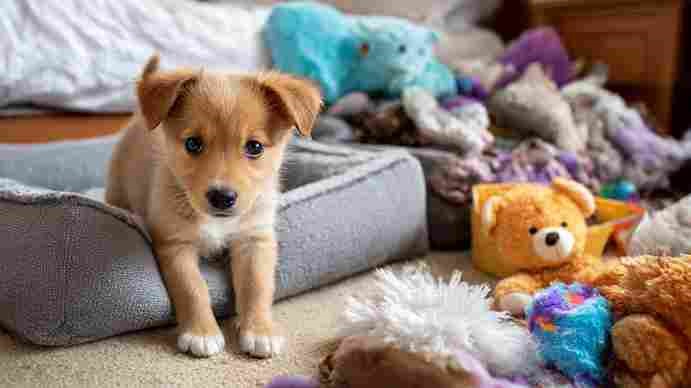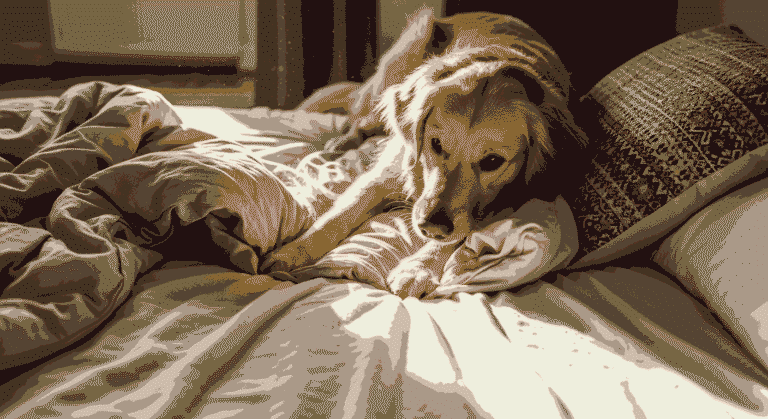What Is Crate Training and How Does It Help a Puppy
Crate training is the practice of teaching a dog to accept confinement to a crate by feeling calm, safe, and comfortable inside it.
Crate training a puppy at night assists with housebreaking, develops a sleep routine, and fosters security. With gentle methods, consistent efforts, and patience, your puppy will learn to peacefully sleep in their crate without fear or fuss.
Quick Summary
- Take your time: Allow your puppy to adapt to the crate during the day first.
- Make it inviting: Provide soft bedding and safe toys to improve the puppy’s comfort.
- Instruct a wind-down routine: Calm your puppy before placing them in the crate.
- Take nighttime potty breaks: Initially, puppies can’t hold it all night.
- Maintain calm during whining: Do not respond to cries unless the puppy needs to go out.
Table of Contents
Why It’s Important to Nighttime Crate Train
Crate training fosters emotional security, helps prevent accidents, and aids in developing better bladder control. It is widely agreed by trainers that successful behaviour and potty training begin with proper crate training.
Nighttime crate training helps reduce anxiety and enables puppies to learn to control their bladder more efficiently, thereby enhancing their overall sense of security and sleep. Observations made by the American Kennel Club indicate that, with proper guidance, puppies can be taught to manage anxiety and learn bladder control much faster.
You might like: How Long Can I Leave My Dog Alone?
Where Should I Put My Puppy’s Crate at Night?
During the initial training period, puppies feel safer when they sleep next to their humans. The crate should be placed in a well-ventilated, quiet but not isolated area.
Recommended crate placement:
- In semi-calm but accessible places like:
- Bedroom
- Living room corner
- Open kitchen
- Bedroom
- Avoid:
- Cold basements and garages
- Noisy areas
- Cold basements and garages
- Ensure:
- Warmth
- Proper airflow
- Your presence nearby
- Warmth
Pro tip: Place the crate next to your bed at first, then incrementally distance it as your puppy gets used to the change.
Should I Feed My Puppy Before Bedtime?

Late feeding leads to accidents at night while sleeping and low-quality sleep overall. Experts recommend not feeding puppies 1–2 hours before bed.
Key points:
- Restrict food and water 1–2 hours before bed.
- Maintain a consistent feeding schedule.
- Puppies often eat or drink not out of hunger but because it’s available.
- Regulated digestion leads to better sleep.
Read more: Dog Healthy Diet Plan: What Every Pet Owner Should Know
Tire Out Your Puppy Before Bed
Puppies that are exercised properly are most likely to fall asleep early and remain asleep for longer periods. Mental activities, coupled with short walks, minimise pre-sleep fidgeting.
Good ways to tire your puppy:
- Age-appropriate strolls
- Short training sessions
- Tug-of-war or fetch games
- Snuffle mats and puzzle toys
Mental and physical energy both matter—tired pups tend to be calm sleepers.
Don’t Play with Your Puppy at Night
Bedtime puppy play promotes stimulation, sets bedtime further in the future, and delays sleep readiness. Nighttime routines need to be calm and consistent to reinforce restful sleep.
- Playtime = Excitement
- Excitement during rest hours leads to confusion.
During nighttime outdoor excursions:
- No games
- No toys
- No interaction
- Use calm voice and a swift potty routine
- Return directly to the crate
This reinforces the idea that it’s sleep time.
Step-by-Step: How to Crate Train a Puppy at Night Time
Following nightly routines and associations will ensure the pup relates the crate to positive feelings. These steps will instil an incrementally adjustable structure into their nightly routine.
Step 1: Start Crate Training During the Day
- Allow your puppy to investigate the crate while calm.
- Deliver meals positioned in a bowl inside the crate.
- Praise and treat with rewards.
Step 2: Create a Bedtime Routine
- Calm them down with gentle activities leading up to sleep.
- Avoid late meals, excitement, or vigorous play.
Step 3: Place Them in the Crate
- Issue a quiet, consistent command such as “bedtime.”
- With a treat, gently guide them inside.
- Stay close to their crate to calm any fears.
Step 4: Respond Appropriately to Whining
- Allow a few minutes before checking on them.
- If they haven’t settled, take them outside for a potty break (no games).
- Bring them back to the crate, maintaining a calm demeanor.
Step 5: Wake Up Before Your Puppy
- To prevent early whining, try to wake before your pup.
- Take them out right away for morning potty.
- This fosters a strong, positive wake-up routine.
Common Mistakes to Avoid

Avoiding common mistakes can enrich your puppy’s learning experience and make it less stressful and easier. The process requires patience, consistency, and positive reinforcement.
- Using a crate as a form of punishment
- Late evening feeding
- Irregular sleep patterns
- Puppy playtime during night toileting walks
- Allowing normal crying to continue for an extended period of time
Nighttime Crate Training Schedule Example
Having a nightly schedule can assist your puppy in adapting to sleeping in the crate. Adhering to a schedule helps your puppy learn when mealtimes, playtime, toilet breaks, and sleep time is.
| Time | Activity |
| 8:30 PM | Last meal of the day (light dinner) |
| 9:00 PM | Toilet break + calming interaction |
| 9:30 PM | In crate with soft toy or chew |
| 2:00 AM | Quiet toilet break if necessary |
| 6:00–7:00 AM | Morning toilet + praise and playtime |
FAQ: Nighttime Crate Training a Puppy
The answers to these questions assist puppy owners in feeling ready and knowledgeable as they go through crate training their puppy at night.
- What is the duration for nighttime crate training a puppy?
As with most things, puppies most often adapt within 1–2 weeks. Other dogs may take longer, and this is where consistent training makes a difference. - If my puppy is whimpering or crying in the crate, should I disregard this behaviour?
Not hearing your puppy at first is fine. Checking if your puppy needs to pee is also necessary. If everything is fine, then waiting a bit is advisable. - Is it acceptable to leave toys or food while in the crate at night?
Certainly. However, be mindful of squeaky toys that will either rouse you or overly excite your puppy. - Is it permissible for the puppy to slumber in my bed?
Not until they are completely crate-trained and housebroken. - What do I do if there is an accident in the crate?
Adjust feeding and potty schedule. Also, clean with enzyme cleaner.
Final Thoughts: Stay Positive and Be Patient
…the first few nights will likely be the hardest… and your puppy is likely to cry or have accidents. With gentle and consistent training, combined with patience and a consistent routine, your puppy will eventually learn to feel safe, relaxed, and happy while in the crate. This is a significant milestone on the path to being a well-behaved dog and builds confidence

Karim Kaifi is an experienced pet owner and writer. He shares practical, research-backed advice based on over 10 years of caring for cats and dogs.






